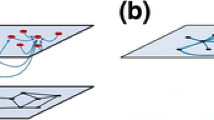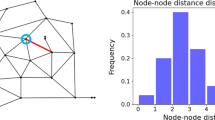Abstract
In this note, we combine two theories that have been proposed in the last decade: the theory of vulnerability and efficiency of a congested network, and the theory of stochastic variational inequalities. As a result, we propose a model that describes the performance and vulnerability of a congested network with random traffic demands and where the travel time can be affected by uncertainty. As an application, we investigate in detail the famous Braess’ network.

Similar content being viewed by others
References
Nagurney, A., Qiang, Q.: A network efficiency measure for congested networks. Eur. Lett. Assoc. 79(3), 38005 (2007)
Nagurney, A., Qiang, Q.: A network efficiency measure with application to critical infrastructure networks. J. Glob. Optim. 40, 261–275 (2008)
Gwinner, J., Raciti, F.: Random equilibrium problems on networks. Math. Comput. Model. 43, 880–891 (2006)
Gwinner, J., Raciti, F.: On a class of random variational inequalities on random sets. Numer. Funct. Anal. Optim. 27(5–6), 619–636 (2006)
Gwinner, J., Raciti, F.: Some equilibrium problems under uncertainty and random variational inequalities. Ann. Oper. Res. 200, 299–319 (2012). https://doi.org/10.1007/s10479-012-1109-2
Jadamba, B., Khan, A., Raciti, F.: Regularization of stochastic variational inequalities and a comparison of an Lp and a sample-path approach. Nonlinear Anal. 94, 65–83 (2014)
Latora, V., Marchiori, M.: Efficient behavior of small-world networks. Phys. Rev. Lett. 87(19), 198701 (2001)
Latora, V., Marchiori, M.: How the science of complex networks can help developing strategies against terrorism. Chaos Solitons Fractal 20, 69–75 (2004)
Murray-Tuite, P.M., Mahassani, H.S.: Methodology for determining vulnerable links in a transportation network. Trans. Res. Rec. 1882, 88–96 (2004)
Jenelius, E., Petersen, T., Mattson, L.G.: Road network vulnerability: identifying important links and exposed regions. Trans. Res. A 40, 537–560 (2006)
Sheffi, Y.: Urban Transportation Network: Equilibrium Analysis with Mathematical Programming Methods. Prentice Hall, Englewood Cliffs (1985)
Chen, X., Zhang, C., Fukushima, M.: Robust solution of monotone stochastic linear complementarity problems. Math. Program. 117, 51–80 (2009)
Agdeppa, P., Yamashita, N., Fukushima, M.: Convex expected residual models for stochastic affine variational inequality problems and its applications to the traffic equilibrium problem. Pac. J. Optim. 6, 3–19 (2010)
Daniele, P., Giuffé, S.: Random variational inequalities and the random traffic equilibrium problem. J. Optim. Theory Appl. 167, 363–381 (2015)
Ravat, U., Shanbhag, U.V.: On the characterization of solution sets of smooth and nonsmooth convex stochastic Nash games. SIAM J. Optim. 21(3), 1168–1199 (2011)
Singh, V.V., Jouini, O., Lisser, A.: Existence of Nash equilibrium for chance-constrained games. Oper. Res. Lett. 44, 640–644 (2016)
Patriksson, M.: The Traffic Assignment Problem. VSP BV, Oud-Beijerland (1994)
Maugeri, A., Raciti, F.: On existence theorems for monotone and nonmonotone variational inequalities. J. Convex Anal. 16, 899–911 (2009)
Braess, D.: Über ein Paradoxon aus der Verkehrsplanung. Unternehmenforschung 12, 258–268 (1968)
Raciti, F., Falsaperla, P.: Improved, non iterative algorithm for the calculation of the equilibrium in the traffic network problem. J. Optim. Theory Appl. 133, 401–411 (2007)
Marcotte, P.: Application of Khobotov’s algorithm to variational inequalities and network equilibrium problems. INFORM 29, 258–270 (1991)
Acknowledgements
The work of Fabio Raciti has been partially supported by University of Pisa (Grant PRA-2017-05).
Author information
Authors and Affiliations
Corresponding author
Appendix
Appendix
We provide some details for the numerical approximation of the solution \(\hat{u}\) of (18) in this section. First, we need a discretization of the space \(X:= L^\mathrm{p} (\mathbb {R}^d,\mathbb {P},\mathbb {R}^k).\) We introduce a sequence \(\{ \pi _n \}_n\) of partitions of the support
of the probability measure \(\mathbb {P}\) induced by the random elements R, S, and D. For this, we set
where
These partitions give rise to an exhausting sequence \(\{\varUpsilon _n\}\) of subsets of \(\varUpsilon \), where each \(\varUpsilon _n\) is given by the finite disjoint union of the intervals:
where we use the multi-index \(h = (h_1,\cdots ,h_m)\) and
For each \(n \in \mathbb {N},\) we consider the space of the \(\mathbb {R}^l\)-valued step functions (\(l \in \mathbb {N}\)) on \(\varUpsilon _n\), extended by 0 outside of \(\varUpsilon _n\):
where \(1_I\) denotes the \(\{ 0,1\}\)-valued characteristic function of a subset I.
To approximate an arbitrary function \(w \in L^\mathrm{p} (\mathbb {R}^d, \mathbb {P}, \mathbb {R}),\) we employ the mean value truncation operator \(\mu _0 ^ n\) associated to the partition \(\pi _n \) given by
where
Analogously, for a \(L^\mathrm{p}\) vector function \(v=(v_1,\dots ,v_l)\), we define
for which one can prove that \(\mu _0^n v\) converges to v, in \(L^\mathrm{p} (\mathbb {R}^d, \mathbb {P}, \mathbb {R}^l)\). To construct approximations for
we introduce the orthogonal projector \(q: (r,s,t) \in \mathbb {R}^d \mapsto t \in \mathbb {R}^m\) and define for each elementary cell \(I_{jkh}^n\),
This leads to the following sequence of convex and closed sets of the polyhedral type:
Since our objective is to approximate the random variables R and S, we introduce
Notice that
Combining the above ingredients, for \(n \in \mathbb {N}\), we consider the following discretized variational inequality: Find \(\hat{u} _n:=\hat{u}_n(y) \in M_{\mathbb {P}}^n \) such that for every \(v_n \in M_{\mathbb {P}}^n\), we have
It turns out that (32) can be split in a finite number of finite dimensional variational inequalities: For every \(n \in \mathbb {N},\) and for every j, k, h, find \(\hat{u}^n_{jkh} \in M^n_{jkh} \) such that
where
Clearly, we have
We recall the following convergence result (see [5]):
Theorem A.1
Assume that \(F(\omega ,\cdot )\) is strongly monotone, uniformly with respect to \(\omega \in \varOmega \), that is
where \(\alpha >0\) and that the growth condition (11) holds. Then the sequence \( (\hat{u}_n ),\) where \(\hat{u}_n\) is the unique solution of (32), converges strongly in \(L^\mathrm{p} (\mathbb {R}^d, \mathbb {P},\mathbb {R}^k)\) to the unique solution \(\hat{u}\) of (16).
Rights and permissions
About this article
Cite this article
Jadamba, B., Pappalardo, M. & Raciti, F. Efficiency and Vulnerability Analysis for Congested Networks with Random Data. J Optim Theory Appl 177, 563–583 (2018). https://doi.org/10.1007/s10957-018-1264-y
Received:
Accepted:
Published:
Issue Date:
DOI: https://doi.org/10.1007/s10957-018-1264-y




